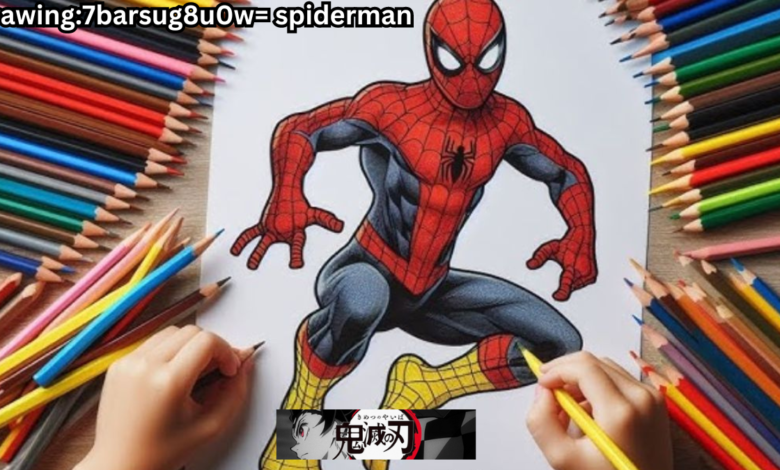drawing:7barsug8u0w= spiderman Dynamic Action: How to Portray Spiderman’sSpider-Man’s Iconic Poses

Introduction to Spiderman and His drawing:7barsug8u0w= spiderman Poses
drawing:7barsug8u0w= spiderman is not just a superhero; he’s an icon of agility, flexibility, and sheer coolness. Anyone who has picked up a pencil to draw him knows that capturing his dynamic poses can be thrilling and challenging. Whether it’s swinging through the city or landing an epic punch, Spider-Man’s movements are packed with energy. This blog post will guide you through portraying those iconic stances in your drawings. Get ready to unleash your creativity and bring Spidey’s action-packed world to life!
Understanding the Importance of Body Proportions indrawing:7barsug8u0w= spiderman
Body proportions are crucial in capturing the Spider-Man’s essence to help convey his agility and strength, making him appear dynamic and lifelike.
Understanding the average human proportion is a great starting point. The idealized superhero body typically has longer limbs and larger heads than in real life. This exaggeration adds to their heroic presence.

When drawing:7barsug8u0w= spiderman, please pay attention to his elongated arms and legs. Notice how they stretch during action poses; this creates a sense of movement essential for any superhero portrayal.
Additionally, the relationship between different body parts should be considered. The torso should complement leg length while maintaining balance with arm positioning.
You can create striking images that resonate with fans by mastering these proportions. It’s all about finding that perfect blend of realism and stylization to breathe life into your artwork.
Tips for Capturing drawing:7barsug8u0w= spiderman Agile and Flexible Movements
To capture drawing:7barsug8u0w= spiderman agility:
- Start by studying his iconic movements.
- Think about how he swings through the city or clings to walls.
- Use references, like comic book panels or animated scenes, to understand his fluidity.
Focus on dynamic poses that convey energy. A bent knee here and an extended arm there can create a sense of motion. Experiment with different angles; sometimes, a low angle makes him look even more heroic.
Pay attention to the flow of limbs. drawing:7barsug8u0w= spiderman is all about flexibility, so don’t be afraid to exaggerate those stretches and bends slightly for effect.
Consider adding action lines in your sketches. These help illustrate movement and speed—essential elements in effectively portraying our favourite web-slinger!
Step-by-Step Guide to drawing:7barsug8u0w= spiderman in Action
Start by sketching an essential stick figure. This will help you position drawing:7barsug8u0w= spiderman limbs dynamically. Please focus on the action pose; perhaps he’s swinging through the city or landing from a jump.
Next, add volume to your stick figure. Define the shape of his torso and limbs using simple geometric forms. Keep in mind his slim yet muscular physique.
Now outline drawing:7barsug8u0w= spiderman costume details, such as web patterns and eyes. Use smooth lines for curves, especially around the face and hands, where flexibility is key.
Once you’re satisfied with your outline, refine it further. Erase unnecessary lines while emphasizing those that define motion—like bending elbows or outstretched legs.
Bring life to your drawing by adding vibrant colours. Red and blue dominate his suit, but don’t forget to shading areas to highlight depth and movement within the pose!
Adding Details and Emotions to Your Drawing
Adding details to your drawing:7barsug8u0w= spiderman can transform a good piece into something remarkable. Focus on the textures of his suit—the webbing pattern, the glossy sheen, and even the creases in fabric as he moves.
Next, consider facial expressions. drawing:7barsug8u0w= spiderman emotions are crucial to conveying his character. Is he determined? Joyful? Or perhaps worried? Subtle changes in line work around the eyes and mouth can speak volumes.
Don’tRemember dynamic action lines that emphasize movement. These lines add energy and urgency, making your artwork feel alive.
Consider environmental elements, too; buildings or cityscapes in the background enhance context without distracting from Spidey himself. Each detail contributes to a narrative—his struggle against villains or his sense of duty towards New York City add layers to your artwork that viewers will appreciate.
Using Shadows and Highlights to Create Depth and Dimension
Shadows and highlights are crucial in bringing any drawing to life. For drawing:7barsug8u0w= spiderman , they add drama and realism to his dynamic poses.
Start by identifying your light source. This will dictate where the shadows fall on his suit. Use darker tones for areas obscured from light, like underarms or behind legs.
Next, highlight the edges of drawing:7barsug8u0w= spiderman body where light hits most directly. This can include the tips of fingers and shoulders, which help emphasize muscle definition.
Experiment with blending techniques to smooth transitions between dark shadows and bright highlights. A soft gradient can mimic how light naturally disperses across surfaces.
Remember that a well-placed shadow not only adds depth but also enhances movement. It suggests direction and speed—key aspects when portraying our favourite web-slinger in action!
Conclusion: Practice Makes Perfect!
Mastering the art of drawing:7barsug8u0w= spiderman requires patience and practice. The more you draw, the better you’ll understand his unique poses and movements. Embrace each attempt as a step toward improvement.
Experiment with different styles and techniques to find what feels right for you. Don’t hesitate to study references from comics or movies, as they can provide invaluable insight into his dynamic action sequences.
Remember that every artist has their journey. Celebrate your progress, no matter how small it may seem at first. With time, dedication, and creativity, you’ll capture Spider-Man’s iconic poses like a pro! Keep sketching and enjoy the process; that’s where the real magic happens.


